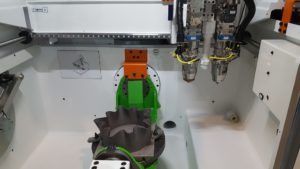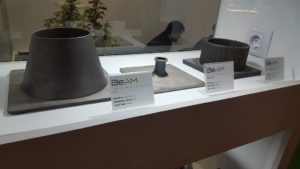 At formnext 2017, France-based BeAM brought its latest introductions, including the first public appearance of the Modulo 400 metal additive manufacturing system and Vincent Gillet, the company’s new CEO. The opportunity to see both for the first time was too good to miss, and the frequent hum of activity at the company’s booth showed that I wasn’t the only one to think so, as I met with the team at formnext again this year.
At formnext 2017, France-based BeAM brought its latest introductions, including the first public appearance of the Modulo 400 metal additive manufacturing system and Vincent Gillet, the company’s new CEO. The opportunity to see both for the first time was too good to miss, and the frequent hum of activity at the company’s booth showed that I wasn’t the only one to think so, as I met with the team at formnext again this year.
Austin Kron, Business Development Manager, introduced me to both, starting with the Modulo 400. This system, with five powder feeders, is similar to BeAM’s Magic system, seen at their Cincinnati location, but a bit smaller. The Modulo 400 fits into a box truck, making it more compact and transportable, bringing BeAM’s directed energy deposition (DED) technology to more applications, such as for the military out in the field, or on an oil rig, to repair parts. Next year, we will see the Modulo 250 emerge, replacing the previous mobile model for an R&D-targeted, modular machine.
BeAM has been moving toward two-part, fully enclosed machines: “The footprint of the machine is the footprint of the machine,” Kron told me, pointing out that the Magic machine we’ve seen in Cincinnati requires the use of external systems set up for laser components.
VP of Business Development Frédéric Le Moullec joined us to showcase some parts from customers in France, which were made within the first month or two of their machines’ installations. BeAM supports its customers through training and programming to ensure that they are able to quickly, and knowledgeably, get their machines up and running. The new Modulo, Le Moullec noted, will see three deliveries in France before the end of the year: to an R&D center at Safran, IRT Saint Exupéry, and OPT’ALM of Groupe Rossi Aero.
 BeAM’s first machine sale outside of Europe is to Nanyang Technological University (NTU) in Singapore, Le Moullec continued, noting the company’s global expansion. NTU bought a Magic system, which will be delivered next year and put to use in research projects, similar to what BeAM has seen with its system installation at the UK’s University of Sheffield.
BeAM’s first machine sale outside of Europe is to Nanyang Technological University (NTU) in Singapore, Le Moullec continued, noting the company’s global expansion. NTU bought a Magic system, which will be delivered next year and put to use in research projects, similar to what BeAM has seen with its system installation at the UK’s University of Sheffield.
“We will be expanding next year into Singapore,” Moullec told me. “We will have a service center branch, starting with technical support for this first customer – and for more to come. This will be more than a sales branch; it will offer technical help and service. It will be a small-scale solutions center like we have in the US.”
CEO Gillet joined us then, as we discussed the implications of geographical expansion and the industry support for such a move.
“We see a lot more industrial people here using traditional manufacturing organization, with classic workshop setups. We see our technology as an add-on – not replacing theirs, but adding a feature,” Gillet told me of BeAM’s positioning.
BeAM, which had previously in its logo usage underscored the message of “Be Additive Manufacturing” now highlights “BeAM DED Industrial Solutions.” Additive manufacturing is part of a whole when it comes to industrial solutions, and BeAM is among the suppliers embracing this fact with a realistic approach.
“DED is repairing parts. Those coming from chemical and metallurgy industries, those doing fittings and pipings, they see our DED technology as a complementary tool. It is not a replacement; they are seeing much more of a complementary technology: it is DED with traditional, adding DED to a workflow,” Gillet told me.
For his part, Gillet comes from a background in metal processing, having worked with traditional manufacturing. He was appointed the CEO of BeAM in August 2017.
“For me, it is interesting to see how this is integrating into the supply chain, how it fits throughout work. This is a more mature business approach, basically how to fit into operation,” he explained. “It’s more than prototyping, more than research – it’s in the production chain. This is a full approach to manufacturing, which includes additive manufacturing.”
As Gillet understands first-hand, with more individuals coming into additive manufacturing from traditional manufacturing backgrounds, industrial technologies stand to benefit from experience and end-to-end understanding.
“People joining the industry now have this background; they are bringing more manufacturing into it, and joining these companies. They have that type of know-how,” he said.
That level of experience is again complementary to developments already at hand in additive manufacturing – building on, and not replacing, or serving as a full solution for, manufacturing. As seen throughout the whole of formnext this year, additive manufacturing is a maturing – not a mature – technology, benefiting from the addition of more voices to the conversation.
“To be honest, this is still not a mature technology,” Gillet underscored. “There is a very optimistic vision for the industry. We are very careful to say we are working toward industrial applications, toward very good prototyping, toward research. You need to work on the stability of lasers, on processes – and this all is what we are working on.”
Discuss formnext 2017, and other 3D printing topics, at 3DPrintBoard.com or share your thoughts in the Facebook comments below.
[All photos: Sarah Goehrke]
Subscribe to Our Email Newsletter
Stay up-to-date on all the latest news from the 3D printing industry and receive information and offers from third party vendors.
You May Also Like
Creality Begins Selling HALOT-MAGE S: Setting New Standards in Precision 3D Printing
Creality, a leading innovator in consumer-grade 3D printing technology, proudly introduces the HALOT-MAGE S, the latest breakthrough in high-resolution 3D printing. With its cutting-edge features and user-centric design, the HALOT-MAGE...
Farsoon Showcases Comprehensive 3D Printing Solutions, Automation, and More at TCT Asia
This year’s TCT Asia event showcased just how much the Asian additive manufacturing (AM) market has grown, with Eplus3D’s 64-laser metal 3D printer alone acting as a synecdoche for China’s...
Creality Launches Ender-3 V3 Plus: Bigger CoreXZ for Unprecedented Performance
Embracing a journey of innovation and excellence, Creality’s Ender-3 series has established a distinguished path in the field of 3D printing. From the entry-level Ender-3 V3 SE to the feature-rich...
Laser Wars: Eplus3D Unveils Metal 3D Printer with up to 64 Lasers
Now that the laser wars in the powder bed fusion (PBF) space have, for the most part, moved to China, original equipment manufacturers (OEMs) there are in fierce competition. Eplus3D...





































